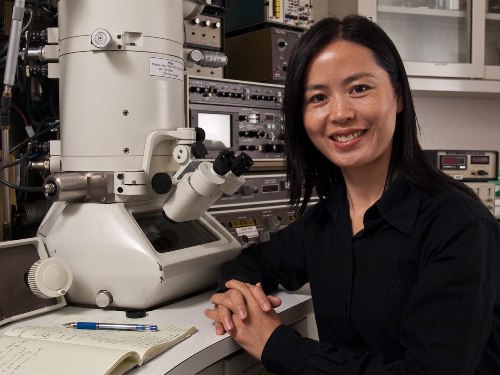A research team headed by Haimei Zheng from the Materials Sciences Division of the Lawrence Berkeley National Laboratory (Berkeley Lab) has experimentally demonstrated a key but controversial hypothesis describing nanocrystal growth.
 Haimei Zheng, a staff Scientist in Berkeley Lab’s Materials Sciences Division and DOE Early Career Research Program Awardee, led the observation of how attached nanoparticles evolve into nanorods. (Photo by Roy Kaltschmidt)
Haimei Zheng, a staff Scientist in Berkeley Lab’s Materials Sciences Division and DOE Early Career Research Program Awardee, led the observation of how attached nanoparticles evolve into nanorods. (Photo by Roy Kaltschmidt)
According to the theory, during nanocrystal growth, nanoparticles behave like ‘artificial atoms’ to create molecular-type building blocks that are capable of assembling into intricate structures. The study results confirmed that nanoparticles behaved like artificial atoms during the growth of nanocrystals.
The research team studied the platinum iron nanorod growth using powerful transmission electron microscopes at the National Center for Electron Microscopy of Berkeley Lab and sophisticated liquid cell handling techniques. Platinum iron nanorods are electrocatalytic materials that show promise in next-generation energy storage and energy conversion systems.
It is essential to understand how nanoparticles act as building blocks in forming complex nanostructures. Scientists can get the information through tracing the growth trajectories of nanoparticles and identifying the forces behind these trajectories. However, so far, researchers were able to observe the growth trajectories, which include nanoparticles’ oriented attachment that initiates the nanocrystal growth in a solution, during the first few minutes of the growth.
Going Straight: The Growth of Nanorods: From Twisty Nanochains
On the other hand, in this study, the Zheng team was able to lengthen the observation time from few minutes to hours. Zheng explained that the key was to keep the solution in the viewing window until the reactions get completed. The researchers introduced an organic growth solution containing platinum and iron molecular precursors into a silicon-nitride liquid cell using capillary pressure. They sealed the cell with epoxy to prevent the liquid from becoming viscous, which inhibits the crystal growth by stopping the nanoparticle interplays.
The transmission electron microscopic study of this solution revealed that only individual nanoparticles were discovered during the start of the crystal growth. However, these nanoparticles initially formed into winding polycrystalline chains by attaching with each other. These chains then aligned and attached end-to-end to create nanowires, which then stretched and straightened into single crystal nanorods. Here, both nanoparticles and nanoparticle chains acted as the basic building blocks to form nanorods.
The study results bridge the gap between the realm of single molecules and complex nanostructures, thus enabling rational design of nanostructures with controlled properties.
Source: http://www.lbl.gov/